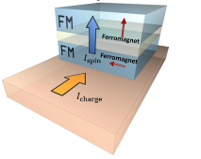Summary
Spintronics seeks to discover and utilize interactions between electron charge and spin. The field has already enjoyed scientific and commercial successes, with the awarding of the Nobel prize for the discovery of magnetoresistance in 2007, and the use of this effect in hard disk drive read heads. More recent advances have enabled the commercialization of magnetic random access memory with all-electrical reading and writing. Although some applications of spintronics are commercially mature, the field continues to provide a wealth of new physics of fundamental interest and potential applications. These new directions in spintronics are primarily driven by the impact of strong spin-orbit coupling.
Description

Schematic of device structure designed to utilize novel spin current generation in a ferromagnet (FM) to achieve electrical switching of a perpendicularly magnetized FM layer
The spin degree of freedom can provide a basis for next-generation electronic devices. Spintronic devices typically include materials with magnetic ordering, such as ferromagnets or antiferromagnets. The state of the magnetization influences charge and spin current through an effect known as magnetoresistance. Magnetoresistance enables a measurement of device resistance to reveal the magnetic orientation. This effect is utilized in magnetic sensors, and is used in read heads in modern hard disk drives. A converse effect is known as spin transfer torque. In this case, charge and spin flow can change the state of the magnetization. Spin transfer torque provides a means of electrically changing the magnetic configuration of a device, thereby acting as a writing mechanism for magnetic memory. The interplay of charge and spin transport and magnetic order additionally opens the way toward other applications such as memristor devices for next-generation computing.
Spin-orbit coupling has recently been shown to provide a new route to novel spintronic devices. Spin-orbit coupling enables the flow of angular momentum between the spin angular momentum of the electronic system and the mechanical angular momentum of the lattice [1]. This provides the opportunity for more energy efficient electrical manipulation of magnetic order. Systems which exhibit substantial spintronic effects due to spin-orbit coupling are typically bilayers composed of thin films of a heavy metal and a ferromagnet. Applying an electric current in the plane of the bilayer results in torques on the magnetization which can lead to magnetic dynamics and switching. We've developed models of the dominant components of these torques, referred to as "field-like" and "damping-like" torques [2]. We've recently shown theoretically [3] and experimentally [4] that the spin-orbit coupling in ferromagnets enables the flow of novel spin currents in these materials, which may have important implications for the behavior of ferromagnet-heavy metal bilayer systems.
Devices based on spin-orbit torques can also utilize unique properties of quantum materials such as topological insulators and two-dimensional transition metal dichalcogenides. We're currently studying materials such as WTe2 and MoTe2 to study the role of symmetry and the spin-dependent Berry curvature in determining the spin-orbit torques present in these systems. The reduced symmetry of the TMD interface enables current-induced torques to switch magnetic layers which are magnetized perpendicular to the film. This is advantageous for memory applications as it provides faster and more energy efficient switching. The convergence of spintronics, 2-D materials, and topological descriptions of the electronic structure opens up opportunities for progress in all three of these broad fields.
Topological properties of materials:
The topological properties of materials’ electronic structure play a central role in their electric response, leading to such phenomena as the quantum and anomalous Hall effects. One signature of nontrivial topological structure is the presence of symmetry-protected surface or edge states, which, like Hall effects, are often detected with transport measurements.
A material's topological properties are typically defined in terms of the evolution of the electron wave function as the crystal momentum is varied; these properties are therefore most naturally understood in periodic crystals. We are interested in the real space properties which determine/are affected by topological characteristics of the electronic structure. A real space formulation of material topological properties can enable spatially resolved measurements of this property in both periodic and non-periodic systems.

